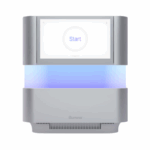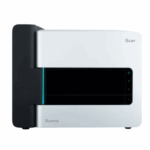USC Norris Comprehensive Cancer Center
An NCI-designated Comprehensive Cancer Center
Molecular Genomics Core
Uncovering the genetic and epigenetic sequence variation that underlies the predisposition, initiation, and progression of cancer is critical within the field of cancer research. As such, the mission of the Molecular Genomics Core (MGC) is to provide services for industry-standard and state-of-the-art molecular and genomic assays in support of USC Norris investigators working across the continuum of basic, translational, clinical and population sciences. The MGC scientific leadership works with USC Norris investigators on the planning, design, conduct, analysis, and reporting for molecular cancer research studies. Thus, the MGC serves as a key foundational element enabling infrastructure and providing molecular platforms and assays for all five USC Norris Research Programs.
Core Offerings
- 10x Genomics Single Cell: A single-cell technology that enables the analysis of gene expression, chromatin accessibility, or study of immune repertoires at the single-cell level, revealing the unique genetic profiles of individual cells. This technology uses microfluidics to partition cells into individual reaction droplets, each containing a unique barcode for downstream analysis.
- 10x Genomics Visium HD Spatial Transcriptomics: A spatial gene expression technology that analyzes gene expression in tissue sections at near single-cell resolution. It captures whole transcriptome data at a resolution of 2×2 micrometers, allowing researchers to map gene expression within the spatial context of tissue. This enables the identification of cell types, anatomical structures, and spatial relationships within tissue samples.
- 10x Genomics Xenium: An in situ technology that enables high-resolution imaging of gene expression within tissue sections. It allows researchers to map RNA transcripts with subcellular resolution and analyze the spatial context of gene expression, including single-cell resolution.
- Bulk NGS: High-throughput sequencing using short-read technologies to capture genomic, transcriptomic, or targeted information from pooled biological samples.
- Bulk RNAseq: Captures and quantifies total or poly-A RNA content from homogenized tissue or cell samples to study differential gene expression across conditions.
- Illumina Infinium Genotyping: High-density array technology enabling genome-wide SNP genotyping with high accuracy and reproducibility.
- Illumina EPIC Array Epigenetics: Detects over 850,000 methylation sites per sample at single-nucleotide resolution for large-scale epigenome studies.
- Oxford Nanopore Long Reads: A long-read sequencing platform that generates reads ranging from short (50 bp) to ultra-long (over 4 Mb). It utilizes nanopores, which are protein channels that allow DNA or RNA molecules to pass through, and measures the changes in ionic current as they move through the pore, allowing for base calling.
Contact Us:
For consultations, submissions, or general inquiries, reach out to us:
Email: coregenomics@med.usc.edu
Phone: (323) 865-0511
Location:
USC Norris Comprehensive Cancer Center
1441 Eastlake Ave
NOR 5312
Los Angeles, CA 90033
Core Policies
-
-
- MGC operates from 9am-5pm Pacific Standard Time Monday-Friday.
- Members contact MGC to inquire and request a quote based upon sample size and receive a rapid response from the Laboratory Manager and Administrator (USC Norris members can also request consultation on the best technology or methodology for their research). A central email contact is used to enable quick responses to users’ questions/inquiries.
- MGC uses standard approaches for service fees; USC Norris full members receive a 10% subsidy on services.
- MGC will provide an initial free consultation to those requesting Core services to determine the feasibility and scope of a project. The potential outputs of the initial consultation period will be a feasibility assessment, project scope, and project plan including cost estimate and timeline. Once the project plan is developed and agreed upon, all further activities will generate Core charges.
- MGC website includes information on available services, and MGC services are also highlighted in Grand Rounds presentations and program meetings.
- MGC sets and communicates project turnaround timeframes with their users, with high adherence.
- At least annually, all equipment undergoes vendor maintenance checks.
- Acknowledgment of the Norris Comprehensive Cancer Center CCSG grant (NCI grant # P30CA014089) in scientific manuscripts is required when MGC services have been provided.
-
How to Submit
Submit DNA samples for array-based genotyping or epigenetic profiling.
Submit extracted DNA or RNA with concentration and purity metrics (e.g., Nanodrop, Qubit, TapeStation/Fragment Analyzer). Contact MGC to discuss appropriate library prep and sequencing strategies.
Submit extracted RNA at ≥20 ng/µL with RIN >7 (for fresh RNA). Consultation required to determine if mRNA, total RNA, or small RNA library prep is most appropriate for your study.
Submit live cell or nuclei suspensions in PBS or nuclei buffer. Pre-run QC (cell count, viability, or nuclei integrity) is optional but recommended. Chromium X will be used for partitioning and library prep.
Submit FFPE or fresh-frozen tissue blocks per Xenium guidelines. For FFPE, RNA quality must meet DV200 >30%
, assessed from adjacent sections. Only intact, well-preserved tissue is accepted to ensure spatial transcript detection.
Submit OCT-embedded fresh-frozen or FFPE tissue blocks, depending on assay version. For fresh-frozen, RIN >7 is preferred; for FFPE, DV200 >50% is required. Tissue quality and morphology are critical. Consultation is recommended for sample preparation.
Submit high molecular weight DNA or RNA. Samples must meet ONT quality metrics (e.g., long fragment sizes, OD 260/280 ~1.8–2.0). Avoid freeze-thaw cycles. Contact MGC for extraction and QC guidance if needed.
Submit high-quality genomic DNA for genotyping or methylation profiling. Samples should be ≥50 ng/µL with OD 260/280 between 1.8–2.0. FFPE-derived DNA may be accepted but must be discussed in advance.
Technologies at MGC

10x Genomics Chromium X: Single-cell and multiome analyses at high throughput

10x Genomics Visium HD: Spatial transcriptomics with high-definition tissue mapping.

10x Genomics Xenium: In situ spatial RNA profiling with subcellular resolution.

Illumina NextSeq 2000: Short-read, high-throughput sequencer.

Illumina Infinium Microarray (iScan): Genotyping and epigenetic profiling using beadlab technology.

Oxford Nanopore Pi: Real-time long-read sequencer using nanopore technology.
